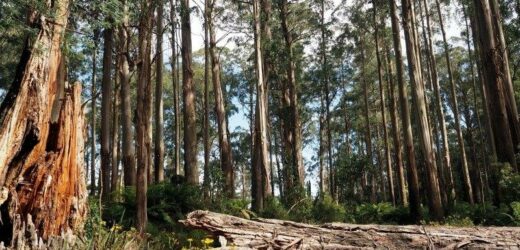The Victorian government’s announcement late last year that it would commit $2.38 million to establish “best practice procedures” for management of regenerated timber-harvesting coupes is welcome, but misses the most important regeneration issue facing our forests – extensive forest loss caused by multiple, landscape-scale bushfires over the past 20 years.
It seems thegovernment is choosing to pave the occasional pothole, while in fact the whole freeway requires resurfacing. Rather than focus only on the relatively small areas managed for timber harvesting, a whole-of-landscape view of regeneration issues must be taken.
A whole of landscape view needs to be taken of forest regeneration in Victoria.Credit:Paul Rovere
All public native forests harvested for timber are required to be regenerated by law, and there are scientific standards and monitoring programs in place to guide this.
However, forest environments are complex and, in rare cases, first-attempt regeneration following harvesting can fail due to weeds, grazing, drought, frost heave and other factors.
There’s no question VicForests must ensure it takes all remedial actions to successfully regenerate harvested sites that have not been successful at first attempt. Conceding forest loss following timber harvesting is not an option.
Once it can demonstrate a harvested forest is successfully regenerated, VicForests is required to hand these areas back to the Department of Environment, Land, Water and Planning as the responsible agency – and it is after this hand-back that ongoing monitoring and management seems to be generally overlooked.
A Victorian mountain ash forest destroyed by bushfire.
If the Government’s proposed solutions mean better stewardship of regenerated forests beyond hand-back, then that is fantastic news for our forests – though $2.38 million will not be enough.
The biggest threat to regeneration, and one that affects all forests, is frequent, severe bushfire – which can kill immature trees before they are old enough to set seed and regenerate naturally. This is now a massive problem in Victoria but gains little coverage. An estimated 32,000 ha of ash forest (equivalent to 16,000 MCGs), across both national parks and state forests, have failed to regenerate following repeated bushfires over the past 20 years.
Thankfully, a large resowing program was undertaken following the 2020 Black Summer bushfires to prevent forest loss in many of these areas.
The 2020 Black Summer program depended on professional forestry skills and was assisted by the substantial experience that has been gained through regenerating timber-harvesting coupes.
However, the program was ultimately limited by insufficient seed in store, and as a result large areas (over 10,000 ha) remain unregenerated.
This is a ticking time bomb in our forests, given the threat of increased fire risk in a rapidly changing climate. At least 140,000 ha of fire-killed ash forest is now in an immature condition in Victoria and at risk of forest loss if burned again within 20 years.
Given all this, the government’s proposed changes need to extend further than VicForests’ timber-harvesting coupes.
Passively allowing nature to take its course will result in further forest loss without active monitoring, management and restoration.
Unfortunately, Victoria lacks the right policy and regulatory settings, institutional arrangements, training and resourcing for the holistic landscape-scale active management and monitoring that are required to combat threats from weeds, pests, browsing, wildfire and other causes of immature forest loss.
A clear vision and new silviculture is required to restore degraded and unregenerated forests. Silviculture – the toolkit of forestry – is the science and craft of creating, managing, conserving, using and caring for forests. “Science” because it requires expertise and learning based on traditional ecological knowledge, measurement and analysis, and “craft” because there is a skill needed to read, connect with and understand forests in ways that can’t always be described by Western science alone.
We urgently need a strategic seed bank and the capacity to recover forests after the big fires of the future, including associated investment in science and a skilled workforce to do this work.
This must be supported by a comprehensive, cross-tenure, landscape-scale forest-monitoring program that enables forest managers to track the success of active interventions and ongoing health of our forests. NSW is ahead of Victoria on this front, having already commenced such a program.
The outlook is grim without such strategies. We will see more forest loss and forest-type changes caused by successive bushfires, leading to terrible loss of biodiversity from these important ecosystems. This will occur under our noses, even in national parks and reserves that the community believes to be notionally protected.
Dr Michelle Freeman is the vice-president of Forestry Australia.
Most Viewed in National
From our partners
Source: Read Full Article




